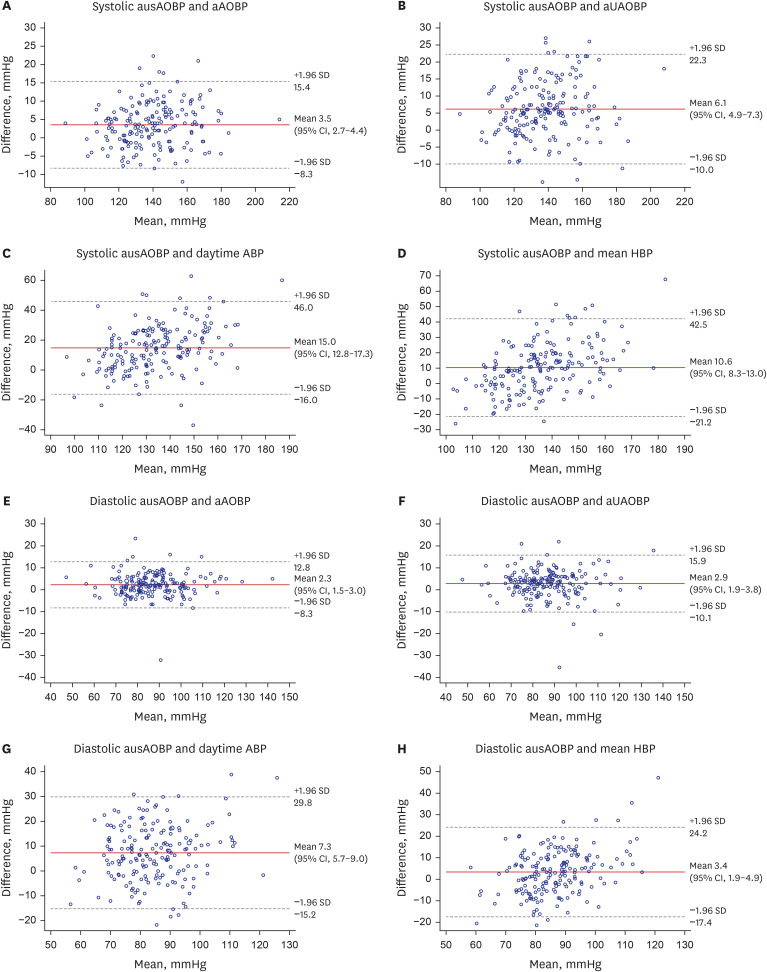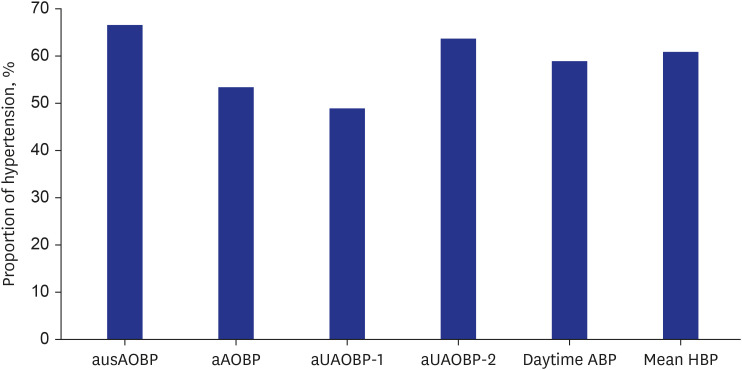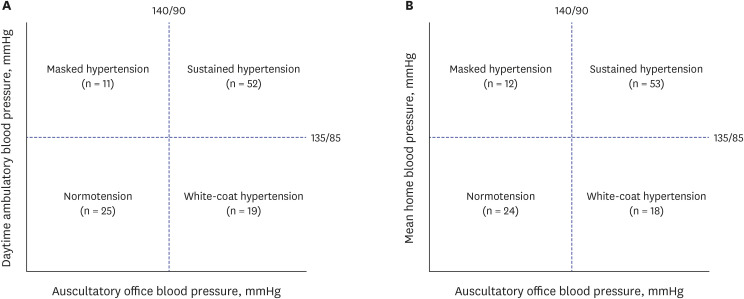J Korean Med Sci.
2023 Dec;38(48):e406. 10.3346/jkms.2023.38.e406.
Comparison of Office Blood Pressure, Automated Unattended Office Blood Pressure, Home Blood Pressure, and 24-Hour Ambulatory Blood Pressure Measurements
- Affiliations
-
- 1Division of Cardiology, Department of Internal Medicine, Kangbuk Samsung Hospital, Sungkyunkwan University School of Medicine, Seoul, Korea
- 2Division of Biostatistics, Department of R&D Management, Kangbuk Samsung Hospital, Sungkyunkwan University School of Medicine, Seoul, Korea
- KMID: 2549168
- DOI: http://doi.org/10.3346/jkms.2023.38.e406
Abstract
- Background
Although previous studies have reported differences of blood pressure (BP) according to BP measurement methods, studies in Korean population were scarce. This study aimed to compare BP differences according to different BP measurement methods and assess hypertension phenotype.
Methods
This prospective study recruited 183 individuals (mean 55.9 years; 51.4% males). The BP measurements included office BP (auscultatory attended office BP [ausAOBP], automated attended office BP [aAOBP], and automated unattended office BP [aUAOBP]) and out-of-office BP (home BP [HBP] and ambulatory BP [ABP]) measurements taken within one week of each other.
Results
The mean systolic/diastolic BP differences between ausAOBP and other BPs according to different BP measurement methods were 3.5/2.3 mmHg for aAOBP; 6.1/2.9 mmHg for aUAOBP; 15.0/7.3 mmHg for daytime ABP; and 10.6/3.4 mmHg for average HBP. The increasing disparity between ausAOBP and other BPs in multivariable regression analysis was significantly associated with increasing BP. The prevalence of white-coat hypertension and masked hypertension in 107 individuals not taking antihypertensive medication was 25.4–26.8% and 30.6–33.3% based on ausAOBP, daytime ABP, and average HBP, respectively. The prevalence of white-coat uncontrolled hypertension and masked uncontrolled hypertension in 76 of those taking antihypertensive medication was 31.7–34.1% and 17.1– 37.1%, respectively.
Conclusion
This study showed a large disparity between office BP and out-of-office BP which became more pronounced when office BP by auscultation increased, suggesting that various BP measurement methods should be used to more accurately assess BP status.
Keyword
Figure
Reference
-
1. Kim HC, Cho SMJ, Lee H, Lee HH, Baek J, Heo JE, et al. Korea hypertension fact sheet 2020: analysis of nationwide population-based data. Clin Hypertens. 2021; 27:8. PMID: 33715619.
Article2. Lee HY, Shin J, Kim GH, Park S, Ihm SH, Kim HC, et al. 2018 Korean Society of Hypertension Guidelines for the management of hypertension: part II-diagnosis and treatment of hypertension. Clin Hypertens. 2019; 25(1):20. PMID: 31388453.
Article3. Kim HL, Lee EM, Ahn SY, Kim KI, Kim HC, Kim JH, et al. The 2022 focused update of the 2018 Korean Hypertension Society Guidelines for the management of hypertension. Clin Hypertens. 2023; 29(1):11. PMID: 36788612.4. Williams B, Mancia G, Spiering W, Agabiti Rosei E, Azizi M, Burnier M, et al. 2018 ESC/ESH Guidelines for the management of arterial hypertension. Eur Heart J. 2018; 39(33):3021–3104. PMID: 30165516.
Article5. Whelton PK, Carey RM, Aronow WS, Casey DE Jr, Collins KJ, Dennison Himmelfarb C, et al. 2017 ACC/AHA/AAPA/ABC/ACPM/AGS/APhA/ASH/ASPC/NMA/PCNA guideline for the prevention, detection, evaluation, and management of high blood pressure in adults: a report of the American College of Cardiology/American Heart Association Task Force on Clinical Practice Guidelines. J Am Coll Cardiol. 2018; 71(19):e127–e248. PMID: 29146535.6. SPRINT Research Group. Wright JT Jr, Williamson JD, Whelton PK, Snyder JK, Sink KM, et al. A randomized trial of intensive versus standard blood-pressure control. N Engl J Med. 2015; 373(22):2103–2116. PMID: 26551272.
Article7. Karnjanapiboonwong A, Anothaisintawee T, Chaikledkaew U, Dejthevaporn C, Attia J, Thakkinstian A. Diagnostic performance of clinic and home blood pressure measurements compared with ambulatory blood pressure: a systematic review and meta-analysis. BMC Cardiovasc Disord. 2020; 20(1):491. PMID: 33225900.
Article8. Pappaccogli M, Di Monaco S, Perlo E, Burrello J, D’Ascenzo F, Veglio F, et al. Comparison of automated office blood pressure with office and out-off-office measurement techniques. Hypertension. 2019; 73(2):481–490. PMID: 30624994.
Article9. Roerecke M, Kaczorowski J, Myers MG. Comparing automated office blood pressure readings with other methods of blood pressure measurement for identifying patients with possible hypertension: a systematic review and meta-analysis. JAMA Intern Med. 2019; 179(3):351–362. PMID: 30715088.
Article10. Kollias A, Stambolliu E, Kyriakoulis KG, Gravvani A, Stergiou GS. Unattended versus attended automated office blood pressure: Systematic review and meta-analysis of studies using the same methodology for both methods. J Clin Hypertens (Greenwich). 2019; 21(2):148–155. PMID: 30585383.
Article11. Kim S, Park JJ, Lee SA, Cho Y, Yoon YE, Oh IY, et al. Diagnostic accuracy of manual office blood pressure measurement in ambulatory hypertensive patients in Korea. Korean J Intern Med. 2018; 33(1):113–120. PMID: 28602060.
Article12. Seo J, Lee CJ, Oh J, Lee SH, Kang SM, Park S. Large discrepancy between unobserved automated office blood pressure and ambulatory blood pressure in a high cardiovascular risk cohort. J Hypertens. 2019; 37(1):42–49. PMID: 30507862.
Article13. Bauer F, Seibert FS, Rohn B, Bauer KA, Rolshoven E, Babel N, et al. Attended versus unattended blood pressure measurement in a real-life setting. Hypertension. 2018; 71(2):243–249. PMID: 29255074.
Article14. Filipovský J, Seidlerová J, Ceral J, Vysočanová P, Špác J, Souček M, et al. A multicentre study on unattended automated office blood pressure measurement in treated hypertensive patients. Blood Press. 2018; 27(4):188–193. PMID: 29334262.
Article15. Andreadis EA, Geladari CV, Angelopoulos ET, Savva FS, Georgantoni AI, Papademetriou V. Attended and unattended automated office blood pressure measurements have better agreement with ambulatory monitoring than conventional office readings. J Am Heart Assoc. 2018; 7(8):e008994. PMID: 29627767.
Article16. Fonseca-Reyes S, Fonseca-Cortés K, Coca A, Romero-Velarde E, Pérez-Molina J. Conventional office blood pressure measurements and unattended automated office blood pressure compared with home self-measurement and 24-h ambulatory blood pressure monitoring. Blood Press Monit. 2023; 28(1):59–66. PMID: 36606481.
Article17. Asayama K, Ohkubo T, Rakugi H, Miyakawa M, Mori H, Katsuya T, et al. Comparison of blood pressure values-self-measured at home, measured at an unattended office, and measured at a conventional attended office. Hypertens Res. 2019; 42(11):1726–1737. PMID: 31222188.
Article18. Myers MG, Valdivieso M, Chessman M, Kiss A. Can sphygmomanometers designed for self-measurement of blood pressure in the home be used in office practice? Blood Press Monit. 2010; 15(6):300–304. PMID: 20975533.
Article19. Lamarre-Cliché M, Cheong NN, Larochelle P. Comparative assessment of four blood pressure measurement methods in hypertensives. Can J Cardiol. 2011; 27(4):455–460. PMID: 21801977.
Article20. O’Shaughnessy MM, Durcan M, Kinsella SM, Griffin MD, Reddan DN, Lappin DW. Blood pressure measurement in peritoneal dialysis: which method is best? Perit Dial Int. 2013; 33(5):544–551. PMID: 23547279.
Article21. Hänninen MR, Niiranen TJ, Puukka PJ, Mattila AK, Jula AM. Determinants of masked hypertension in the general population: the Finn-Home study. J Hypertens. 2011; 29(10):1880–1888. PMID: 21841499.22. Ihm SH, Park JH, Kim JY, Kim JH, Kim KI, Lee EM, et al. Home blood pressure monitoring: a position statement from the Korean Society of Hypertension Home Blood Pressure Forum. Clin Hypertens. 2022; 28(1):38. PMID: 36180964.
Article
- Full Text Links
- Actions
-
Cited
- CITED
-
- Close
- Share
- Similar articles
-
- Clinical Implications of Ambulatory and Home Blood Pressure Monitoring
- Office Blood Pressure is Higher than Home Blood Pressure, and Digital Electronic Sphygmomanometer is Useful for Self-Monitoring of Blood Pressure in Hypertensive Patients
- Home Blood Pressure Monitoring Has Similar Effects on Office Blood Pressure and Medication Compliance as Usual Care
- Comparison of Blood Pressure Control and Left Ventricular Hypertrophy in Patients on Continuous Ambulatory Peritoneal Dialysis (CAPD) and Automated Peritoneal Dialysis (APD)
- Clinical Significance of Nighttime Blood Pressure




